A frozen shoulder, also called adhesive capsulitis, is a painful shoulder condition that causes stiffness, shoulder pain, and loss of range of motion. The condition develops when the shoulder joint capsule thickens and tightens, often forming scar tissue that restricts normal movement.
Without treatment, a frozen shoulder can take 12 to 18 months—or longer—to improve. Fortunately, a variety of frozen shoulder treatments can help patients manage pain, restore mobility, and return to normal activities.
Symptoms and Causes of Frozen Shoulder
Frozen shoulder typically develops gradually and progresses through three stages:
-
Freezing stage: Pain increases and the shoulder becomes stiff, making it difficult to move.
-
Frozen stage: Pain may lessen, but shoulder stiffness remains.
-
Thawing stage: Gradual improvement in range of motion as the shoulder begins to recover.
Causes of frozen shoulder are not always clear, but risk factors include:
- Prolonged immobilization of the shoulder (after injury or surgery such as a rotator cuff repair)
- Inflammation of the joint capsule
- Medical conditions such as diabetes, thyroid disorders, or cardiovascular disease
Shoulder injury or systemic conditions can increase the risk of developing frozen shoulder.
Diagnosis and Conservative Treatment
Diagnosis is typically made with a physical exam and medical history. Imaging studies such as x-ray or MRI may be used to rule out other common shoulder conditions like rotator cuff tears.
In many cases, conservative treatment is effective. Options include:
- Physical therapy: Guided shoulder exercises and stretching exercises to improve mobility and prevent stiffness.
- Pain relief: Application of ice to the shoulder, use of anti-inflammatory drugs, or steroid injections into the shoulder joint.
- Passive range of motion exercises: Assisted movements that help maintain flexibility.
Advanced Treatment Options
If conservative treatment does not adequately improve shoulder motion or relieve pain, more advanced interventions may be considered:
- Manipulation under anesthesia (MUA): The shoulder is gently moved while the patient is under anesthesia, helping to stretch the scar tissue and capsule.
- Shoulder arthroscopy: A minimally invasive procedure where small incisions around the shoulder allow a surgeon to release tight portions of the joint capsule.
Both procedures can help release a frozen shoulder and restore the ability to move your shoulder.
Recovery and Prognosis
Most patients respond well to a structured treatment plan for frozen shoulder. While recovery can take several months, the shoulder can usually regain normal function with the right combination of physical therapy, pain management, and—if necessary—surgery.
The key is early diagnosis, proper treatment, and a commitment to rehabilitation exercises to prevent long-term stiffness.
Frozen shoulder (adhesive capsulitis) is a painful condition that limits shoulder mobility. With the right diagnosis and treatment options—ranging from physical therapy and steroid injections to arthroscopy or manipulation under anesthesia—patients can gradually recover motion, reduce pain, and return to everyday activities. Contact Dr. Sileo today to discuss treatment options and start your recovery!




